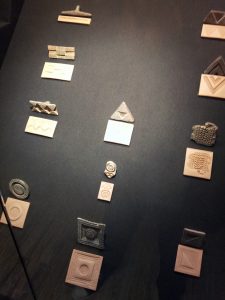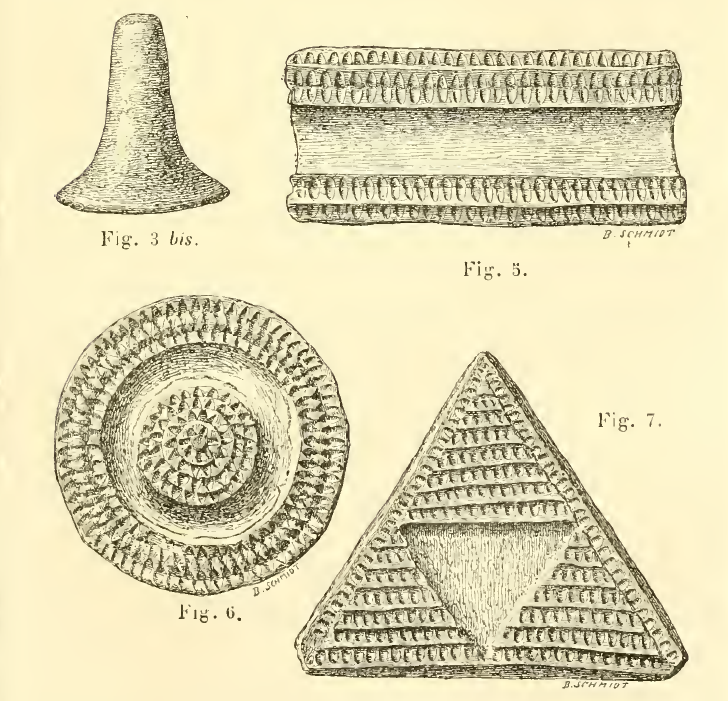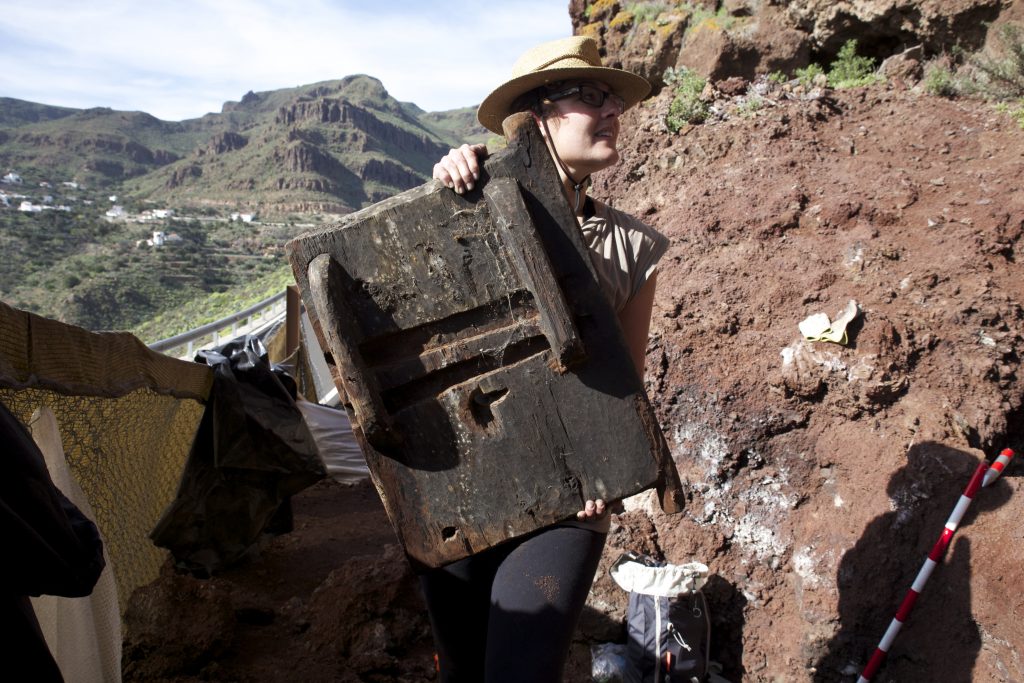The indigenous artifacts known as pintaderas are some of the most remarkable objects of study and analysis to the Canarian archeology. These are small tools made of baked clay –terracotta– or wood, featuring geometric patterns of varying complexity –triangles, circles, rectangles, broken lines– being either incised, excised and/or printed on a round or polygonal flat surface called field, and generally provided with an appendix, often perforated by one or more holes.
The word pintadera (bakery stamp), according to the RAE dictionary, means an instrument used to decorate the upper side of bread or other things with certain patterns.[1]This translation by PROYECTO TARHA. In the late nineteenth century, Professor René Verneau testified this was the name that people of Santa Lucía de Tirajana gave these objects together with the more prosaic word stamp, and it is from that point when such a designation starts to be widespread used in the scientific field.
The popularity of pintaderas increases since the publication of the Manifesto of El Hierro (1976), in which first article they are considered as representative of the Archipelago identity, although its geographical context is exclusively the island of Gran Canaria.
Although more than five hundred of these items have been found to date -see an extensive collection of samples in the catalogue and study published by El Museo Canario prepared by Drs. María del Carmen Cruz de Mercadal and Teresa Delgado Darias, and Professor Javier Velasco Vázquez-, their true function, enigmatic for now, remains controversial but due to the above features it is commonly accepted that pintaderas are stamps or matrices whose functionality may have been:
- Body, textile and/or ceramic printing using dyes.
- Ideogram printing.
- Goods possession markers, especially for granaries.
- Personal, familiar and/or tribal identification.
- Mystical-religious tools.
- Amulet (healing, personal protection, etc.).
- Some combination of these or other applications.

Partial view of the collection of pintaderas exposed at El Museo Canario with their respective experimental printings on clay (fuente: PROYECTO TARHA).
Views on the pintaderas functionality
Informally, we could classify different views on the role of pintaderas –all of them firstly raised during the last third of the nineteenth century– in three interpretive currents, not mutually exclusive:[2]For a summary of various interpretive theories, see CRUZ (2013, pp. 119-137).
Ornamental function
Defended by Naturalist Sabin Berthelot and Professor René Verneau. Subsequently adopted by researcher Diego Ripoche y Torrens, and Dr. Juan Bethencourt Alfonso.
According to this hypothesis, the pintaderas might have been used to decorate indigenes’ bodies and / or adorning household items such as textiles and ceramics. In favor of this theory can be argued the testimony of the early chronicles claiming that ancient Canarians painted and even tattooed their bodies, without specifying what instruments were used for this. On the other hand, some remains of indigenous textile confections show geometric motifs drawn using some kind of template. However, the virtual absence of dyeing waste on recovered pintaderas cast doubt on this idea.
Sealing function
Adduced by Professor Carlos Pizarroso y Belmonte, and developed in the 1940s by Professors Georges Marcy and Dominik Josef Wölfel. According to this view, the role of pintaderas would be that of a stamp on any of its variants –individual, family or tribal blazon; ownership mark, etc.–, either using dyes or by printing on plastic material –clay–.
Ideogrammic function
Some thoughts on the pintaderas
What could be the true function of these objects? Our remarks are as follows:
- From a contextual point of view:
- They are elements whose presence is relatively abundant in Gran Canaria archaeological sites, generally associated with population centers, so they should be frequently used objects.
- They are scarcely reflected in ethnohistorical sources, so unlike milk offerings and idolatry, their usefulness should pass unnoticed to the conquerors and chroniclers, or at least, they were not deemed important enough to be noted.
- It seems clear that their use was intrinsically linked to certain unique aspects of the Grandcanarian indigenous culture that became irrelevant or incompatible with colonial structures, since such an use is extinguished presumably after the conquest. Not the case of other objects, such as manual cereal mills, pottery and other utensils from everyday life that were not initially displaced or discarded by the new colonial society.
- From an ergonomic point of view:
- It is unlikely they were used as dye stamps, as remains of this type of product have not been found on most pintaderas. On the other hand, dyeing patterns appearing upon surviving indigenous ceramics and textiles seem drawn freehand mostly, and as to their hypothetical application on human skin, it is unlikely a physical confirmation could be achieved for obvious reasons. It should be noted here, however, that many of the pintaderas incorporated into the first ethnographic collections were subjected to washing after their discovering, apart from other processes that could alterate their original condition.
- Presence of a drilled appendix in practically all found pintaderas suggests a hanging element, but in our opinion nothing in the likes of an amulet or ornamental type, because if so, it would be plausible that the geometric field should be exposed to view of other people and not down at the feet of the bearer, unless some unknown indigenous cultural rule dictated otherwise. Therefore, the appendix –a handle in this case– reinforces the idea of a stamp, and the borehole does likewise to the pendant idea in order to facilitate the bearer hold hands with other tasks while not using the object.
If indeed we had come upon a dyeless stamp, what kind of we would be talking about? Let us highlight two of the existing hypotheses:
The pintaderas as possession markers
In the absence of dyeing remains our view tends to opt for the theory of the ownership markers; that is, a pintadera would be an identification stamp, not only intended to point social status or membership to a household or lineage, but the possession of a good and, in addition, authorization to access it. A merger between an identity document and a key.
We know the chronicles of the Conquest attest to the existence of communal granaries in Gran Canaria, possibly guarded by watchmen under control by the indigenous noblemen.[4]For example, see MORALES (1978, p. 436).
If members of a certain community -clan, family, etc.– put a part of their harvest aside to a collective granary, they possibly transported the grain –and maybe other perishable products– in ceramic containers and deposited them in one or more of the niches that made up the granary, which would then be conveniently closed under the supervision of the guardian in charge.
Closure would be safely made, not using dye to seal the niche door but dry printing the pintadera field patterns on a semisolidified clay pellet or plate, after sealing the door with the latter. A similar case can be found in the seals of the fortified granaries of the Algerian Aurès region, referred to by Professor Marcy.
If a granery guardian wanted to verify the identity of a consumer who would come around to pick up supplies before allowing the breaking of the seal, he could check out by simple visual inspection the equivalence between the pintadera of the person concerned and the mark printed on the plastic material. Also, simplest sketches of the geometric matrix could make possible a final verification, checking out whether the pintadera would fit physically into the negative printed on the plate or pellet. Afterwards, the grain bearer would walk to its destination carrying the food containers with the stamp hanging comfortably round his/her neck. Thus, this would be a hard-to-counterfeit identification method.
The confirmation of this theory could presumably be found in less plundered granaries, although we deem difficult to find a clay plate or pellet in good condition as we imagine it, with a pintadera negative still printed.

Reiteration of compositive patterns on pintaderas from different geographic areas of Gran Canaria (source: CRUZ (2013), p. 142.).
The pintaderas as ideograms
As we noted above, the authors of the catalogue of pintaderas published by El Museo Canario, Drs. María del Carmen Cruz de Mercadal and Teresa Delgado Darias hypothesize an ideographic function for these objects, based on the iteration of field’s geometric patterns in various specimens found in locations distant from each other, reinforcing the idea of conscious reuse of similar compositional schemes and presumably their relationship with some certain self-identifying symbology of Gran Canaria own indigenous society.[5]CRUZ (2013, pp. 139- 147).
Acknowledgements
We would like to acknowledge and thank Professor Jorge Onrubia Pintado his clarifying amendments to this post.
To be continued…
References
- Pintaderas de El Museo Canario. Las Palmas de Gran Canaria: El Museo Canario.
- Canarias: Crónicas de su conquista. Ayuntamiento de Las Palmas de Gran Canaria – El Museo Canario.
- “Sellos y marcas de propiedad de graneros fortificados del Aurès (Argelia). Consideraciones etnoarqueológicas en torno a las presuntas correlaciones norteafricanas de las pintaderas de Gran Canaria“. Trabajos de Prehistoria, 43, pp. 281-307. Madrid: Centro de Ciencias Sociales y Humanas – Consejo Superior de Investigaciones Científicas.
- Verneau, R. (1883). “Las pintaderas de Gran Canaria”. Anales de la Sociedad Española de Historia Natural, 12, pp. 319-339. Madrid: Sociedad Española de Historia Natural.



Pingback: Las pintaderas canarias – EL TALLER DE BELLA